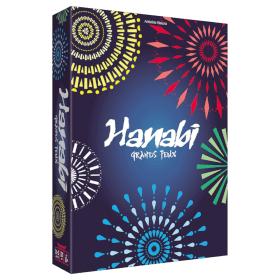Hanabi / ฮานาบิ
 ในเกมนี้ผู้เล่นทุกคนต้องทำงานร่วมกันเพื่อสร้างการจุดพลุที่สวยงาม
ในเกมนี้ผู้เล่นทุกคนต้องทำงานร่วมกันเพื่อสร้างการจุดพลุที่สวยงาม
แต่ผู้เล่นทุกคนจะต้องถือการ์ดของเขาไว้ด้านหน้า: คุณไม่สามารถเห็นไพ่ของคุณเอง!
ดังนั้นคุณต้องให้คำแนะนำอย่างชาญฉลาดแก่พันธมิตรของคุณและจดจำข้อมูลทั้งหมดที่รวบรวมได้
จำนวนผู้เล่น: 2 - 5
ระยะเวลาของเกม: 10 mn
ความซับซ้อน: 2 / 5
เล่น Hanabi / ฮานาบิ และ 1194 เกมอื่นๆ ออนไลน์
ไม่จำเป็นต้องดาวน์โหลด - เล่นได้โดยตรงจากเว็บเบราว์เซอร์ของคุณ
กับเพื่อนและผู้เล่นนับพันจากทั่วโลก
ฟรี.

เล่น Hanabi / ฮานาบิ และ 1194 เกมอื่นๆ ออนไลน์
ไม่จำเป็นต้องดาวน์โหลด - เล่นได้โดยตรงจากเว็บเบราว์เซอร์ของคุณ
กับเพื่อนและผู้เล่นนับพันจากทั่วโลก
ฟรี.

กฎย่อ
Introduction
Hanabi is a cooperative game. Your goal, as a team, is to build fabulous firework show. You do this by playing the cards in the right order. However, you cannot see your own cards; you can only see the cards of your team mates.
Gameplay
You each take turns. During a turn, a player may take one (1) action. After his action, his turn ends and it is the next player's turn. The game can end in three ways:
1) All cards have been taken from the deck. After this happens, everybody gets 1 more turn. You win the game with the score at the last turn.
2) You have reached the maximum score possible. In this case you win the game with maximum score.
3) You have made three mistakes that caused a misfire. In this game you lose the game, and get 0 points.
Turn
During your turn, you get one (1) action. With this action you can chose to do one of the following:
1) Give a clue. This costs a clue-token (-1). You cannot give a clue if there are 0 clue-tokens left. When you give a clue, you can indicate ALL cards of a certain colour, or ALL cards of a certain number.
2) Play a card. When a card is played, it is evaluated if the card fits in the sequence. If it does, it is placed on the table. If it does not, it is placed on the discard pile and you get a misfire-token.
3) Discard a card. When you discard, the card is placed on the discard pile and you get a clue-token (+1). Note: cards on the discard pile are out of the game and can never return.
When you remove a card from your hand, by either playing or discarding, at the end of your turn, you get a new card. Your newest card is always placed on the left.
Lingo
When you play with others, certain words are used to describe certain objects or situations. Here is a short list.
CHOP The oldest, unmarked card. The right-most card that you have no information on.
DRAW The newest, unmarked card. The left-most card that you have no information on, this will almost always be the left card.
TO BOMB A play that causes a misfire-token. Sometimes also called EXPLOSION
MARKED A card that is highlighted by a clue.
UNMARKED A card that is not marked.
DOUBLE DISCARD Discarding the CHOP card when it can be a copy of the card that was discarded in the last move.
DOUBLE SAVE To mark a card that is useless, because the copy of the card is already played, or marked.
UNIQUE A card that has no copy (left) in the deck.
STRATEGY A set of rules / guidelines on how to interpret moves done by players (including spending of clue-tokens).
Cards
In a game of Hanabi on NORMAL DIFFICULTY, there are 5 colours of cards of value 1 to 5. In each suit there are: -three 1s -two 2s -two 3s -two 4s -one 5 This makes 10 cards per colour.
There are three variants that add a 6th colour: the multicolour. 1) TRICKY DIFFICULTY adds 10 multicolour cards to the normal game. These cards get marked by a separate multicolour clue. 2) HARD DIFFICULTY adds 5 multicolour cards to the normal game: one of each. These cards get marked by a separate multicolour clue. 3) VERY DIFFICULT DIFFICULTY adds 10 multicolour cards to the normal game. These cards get marked by ANY colour clue.
ELO rating
If you are playing with ELO rating on, your ELO may be changed at the end of the game.
Here is how it works:
1) Every player on the team is temporarily considered as having the average ELO rating of the team.
2) The system will generate a bot associated with the score your team has achieved (let’s call it Hanabot). Hanabot’s ELO rating depends on the variant you are playing (50 cards, 60 cards, 60 cards multicolor), the number of players on the team and, most importantly, your team's score. All Hanabot’s ELO ratings have been set by an experienced player, they are not random or simply proportional to the score/number of players.
3) Your team (actually your team's average ELO) will now compete against Hanabot. The system will calculate your team’s ELO gain/loss as though your team had tied with Hanabot. If your score is below 18 (50-card game) or below 21 (60-card game), Hanabot's ELO is always 1000.
You can find all bots' ELO ratings here: http://forum.boardgamearena.com/viewtopic.php?f=3&t=4814
The 55-card variant (50 cards + 1 of each value in the sixth color) cannot be played with ELO rating on. This is because this variant is highly dependent on draw and a team’s score may not always reflect the players’ skills.
If you achieve the perfect score and this should cost you ELO points, you will be considered as having beaten the bot associated with the score, so that you lose no ELO points.
To be confirmed: I think the ELO-system has had an overhaul.
About "cheating"
In the "real life Hanabi", you can talk. That's why we chose to let the chat open for the online version.
As a consequence, it is very easy to cheat at Hanabi. However, as you can imagine, cheating is very stupid and has no interest... except for ELO boosting. This is why there is no international ranking for this game (ie: best player, second best player) and no trophies associated to it.
Strategy
Please refer to the BGA strategy guide here.


